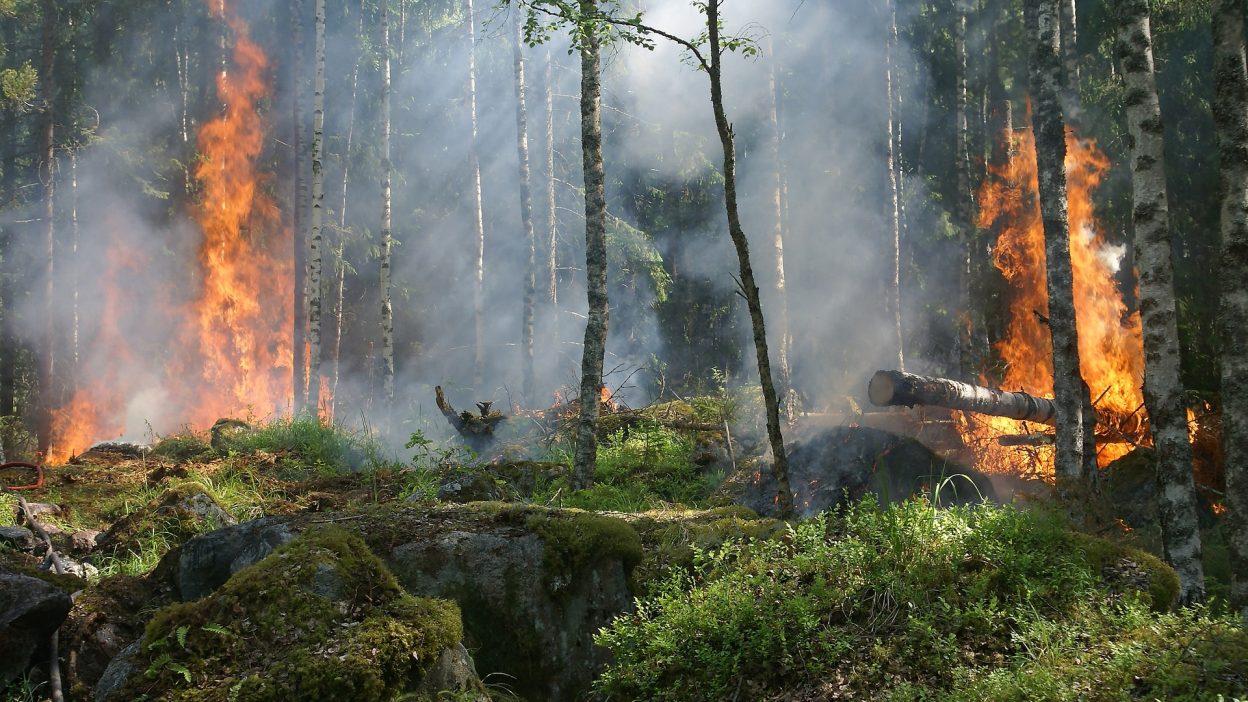When Indonesian Forest Fires Choked an Entire Nation
1. A Firestorm Unleashed: How the 1997 Indonesian Forest Fires Began
The 1997 Indonesian forest fires are remembered as one of the most devastating environmental crises of the late 20th century, wreaking havoc on Indonesia and its Southeast Asian neighbours. These fires did not simply arise due to natural causes; they were the outcome of human activity, exacerbated by illegal land-clearing techniques and the drought triggered by El Niño. The slash-and-burn method, used extensively by landowners to clear areas for farming, played a critical role in igniting these fires.
Indonesia’s tropical rainforests, already under immense strain from deforestation, became highly vulnerable to the flames. The El Niño weather system played a pivotal role by creating an extreme drought that left vast swathes of forested land extremely dry and flammable. The dry conditions made the forest floor, particularly in peat-rich areas, the ideal fuel for devastating wildfires.
By the time the fires ignited, they had grown out of control. Illegal agricultural practices such as slash-and-burn were not only widespread but also had government complicity. With little oversight, farmers and corporations continued to set fires to clear land for palm oil plantations and timber extraction, thinking that it was an easy and cost-effective approach to preparing land for commercial use.
The Indonesian government, however, failed to take adequate precautions or provide proper resources for preventing fires. The government’s lack of regulatory enforcement allowed corporations to continue their operations unchallenged, thus turning the fire into an uncontrollable disaster.
2. The Inferno Spreads: When Flames Swallowed Indonesia’s Jungles
As the fires gained momentum, they quickly spread across vast parts of Sumatra, Kalimantan, and other regions of Indonesia. These areas, which housed some of the world’s most biodiverse rainforests, were wiped out in a matter of months. The fires were not just surface-level; they reached into peatlands, which burn much more intensely and for a much longer period, creating an almost impossible-to-extinguish scenario.
The damage to Indonesia’s wildlife was catastrophic. Orangutans, tigers, rhinos, and countless other species were displaced, with many losing their lives as their homes turned to ash. The forest fires didn’t just devastate the land—they devastated entire ecosystems. As vital habitats disappeared, many animals were left with no place to go, and their populations dwindled to the brink of extinction.
The fire also brought significant consequences to local human communities. Thousands of people, particularly rural farmers, found themselves in harm’s way. Villagers were trapped in the middle of fires, many suffering from severe burns, respiratory distress, or even death.
The smog created by the fires extended far beyond Indonesia’s borders. Countries like Malaysia and Singapore also became engulfed in thick, toxic air, while other Southeast Asian nations experienced widespread disruptions to their daily lives.
3. A Crisis of Smoke and Death: The Human Toll of the 1997 Fires
- Toxic Haze Engulfs Southeast Asia
The fires didn’t just affect the areas where they started; the smoke and haze spread across vast parts of Southeast Asia, including Malaysia, Singapore, Brunei, and Thailand. The smog was thick and dangerous, with visibility reduced to near zero in some regions. Major cities were enveloped, and air quality levels plummeted. The widespread toxic haze led to serious health problems for millions of people, and hospitals were overwhelmed with patients suffering from respiratory issues. - Millions Suffer from Respiratory Illnesses
The pollutants released into the atmosphere from the fires were extremely dangerous. Fine particulate matter (PM2.5), carbon monoxide, and other hazardous chemicals entered people’s lungs, causing severe respiratory problems. People in affected areas, including children and the elderly, suffered from asthma attacks, chronic coughs, and acute respiratory infections. These health issues were not limited to the immediate aftermath but persisted for months after the fires had been contained. - Death Toll Soars Due to Air Pollution
While the exact number of fatalities remains difficult to determine, estimates suggest that at least 24,000 people died prematurely due to complications from the hazardous air. The death toll was primarily linked to respiratory and cardiovascular diseases, particularly among vulnerable populations like the elderly, children, and those already suffering from pre-existing health conditions. In many areas, the healthcare system was ill-prepared, and many communities struggled to access basic medical care. - Economic Devastation Worth Billions
The economic impact of the fires was staggering, with $9 billion in losses due to the destruction of forests, agricultural lands, and the costs associated with public health care and firefighting efforts. The fires caused widespread damage to Indonesia’s timber and palm oil industries, with many businesses seeing their operations halted or destroyed. In addition to the immediate loss of crops and timber, the long-term effects included reduced agricultural yields, which would take years to recover.
4. Nature’s Wrath or Man’s Greed? Who Is Responsible for the Fires?
The 1997 forest fires were not simply an act of nature or a random disaster; they were the result of human choices and irresponsibility. While El Niño conditions certainly played a role in intensifying the drought, it was illegal land-clearing practices that turned a dry spell into an unprecedented disaster. Corporations engaged in unsustainable practices to clear vast tracts of land for plantations and industrial projects, often without proper safeguards or environmental consideration.
One of the primary causes was the practice of slash-and-burn farming, which is both cheap and effective for clearing land quickly. However, it has devastating consequences for the environment, as the fires often escape control and become uncontrollable infernos. The Indonesian government’s failure to enforce regulations allowed these practices to continue unabated.
Furthermore, corporate greed compounded the problem. Timber companies, often linked to political elites, disregarded environmental laws and contributed to the illegal deforestation. This enabled them to expand their operations without facing the penalties or consequences they deserved. Consequently, the Indonesian government failed to hold the companies accountable, allowing the situation to spiral out of control.
5. The Great Haze: When Indonesia’s Disaster Became an International Crisis
As the fires spread across the Indonesian archipelago, they became a regional crisis that affected neighbouring countries. Malaysia, Singapore, and Brunei were particularly hard hit by the smog, with air quality levels plummeting to dangerous levels. These countries, which share a close proximity to Indonesia, found themselves under the haze’s choking grasp.
The diplomatic fallout was immediate. Malaysia and Singapore both blamed Indonesia for the disaster, accusing the Indonesian government of failing to take appropriate action to prevent the fires. The ASEAN nations demanded that Indonesia take responsibility and address the root causes of the crisis. Yet, despite pressure from regional leaders and environmental organisations, Indonesia’s response was inadequate, leading to further frustration and heightened tensions in the region.
Beyond the political dispute, the human cost of the haze was severe. In Malaysia and Singapore, schools were closed, flights were grounded, and millions of people had to wear face masks to shield themselves from the toxic air. This environmental disaster became a global crisis that highlighted the dangers of unchecked industrial activity and its far-reaching consequences.
6. An Environmental Catastrophe: The Long-Term Damage to Indonesia’s Ecosystem
The fires of 1997 did not just burn the land; they scarred Indonesia’s ecosystem for years to come. Over 2.5 million hectares of tropical rainforest were destroyed, and with it, vast amounts of biodiversity were lost. The destruction of habitats pushed many species of animals, including endangered orangutans, tigers, and rhinos, closer to extinction.
The environmental consequences extended far beyond the immediate loss of vegetation. Peatlands, which are known for being carbon-rich, emitted massive amounts of carbon dioxide into the atmosphere, making Indonesia one of the biggest carbon polluters in 1997. The scale of the destruction also accelerated climate change, contributing to global warming and further environmental instability.
Despite international calls for the protection of Indonesia’s forests, illegal deforestation has continued, and large sections of land are still barren from the 1997 fires. Reforestation efforts have been slow and inadequate, with many areas still recovering. The Indonesian government, in the years following the fires, introduced new environmental policies but faced constant challenges due to poor enforcement and the ongoing demand for land for palm oil and other industries.
7. The Silent Victims: Indigenous Communities & Poor Farmers Left to Die
- Local Tribes Lost Their Lands and Homes
The fires were particularly devastating for Indonesia’s indigenous communities, who lived in the forests that were set ablaze. For many, the land was their home and livelihood, and as the fires spread, they had no place to go. Villages were destroyed, and entire communities were displaced. - Health Crisis in Rural Villages
While larger cities received attention and aid, the rural communities were largely forgotten. Many poor farmers and indigenous people lacked access to healthcare, and respiratory diseases spread rapidly. With no proper medical infrastructure in place, many of these vulnerable groups suffered in silence as their health deteriorated. - The Government Ignored the Poor
The Indonesian government’s response to the crisis was slow and inadequate. Corporate interests received priority, while rural communities and indigenous tribes received little to no aid. Many communities were left without compensation for
the damage to their homes and livelihoods.
8. The Political Fallout: Indonesia Faces International Criticism and Internal Unrest
The 1997 fires did not just bring an environmental disaster—they sparked political unrest both domestically and internationally. The Indonesian government faced intense criticism from both the international community and its own citizens. The fire was seen as a symbol of the government’s failure to address environmental concerns and enforce regulations.
International organisations, including the United Nations, demanded that Indonesia take responsibility for the disaster and take immediate steps to prevent future occurrences. However, Indonesia’s reluctance to accept blame led to strained relations with neighbouring countries. Within Indonesia, there was also growing dissatisfaction among citizens who felt that the government was more concerned with economic development than the welfare of its people and the environment.
9. The Aftermath: Steps Toward Recovery and Lessons Learned
After the fires were finally brought under control, the task of rebuilding Indonesia’s devastated forests began. The Indonesian government, in collaboration with international organisations, launched reforestation programmes to restore some of the damaged ecosystems. However, the process was long and difficult, with many areas remaining barren for years after the flames had been extinguished.
The fire highlighted the need for stronger environmental laws and more robust regulations in Indonesia. While some progress has been made, the fight for the preservation of Indonesia’s rainforests continues to this day.
10. Conclusion: A Nation’s Wake-Up Call – The Fires That Changed Indonesia
The 1997 Indonesian forest fires serve as a grave reminder of the destructive power of human actions on the environment. While the fires themselves were a natural disaster, the sheer scale of the devastation was made possible by human negligence and irresponsibility. The crisis revealed the devastating consequences of deforestation and the need for environmental reforms.
It also exposed the dark underbelly of the global palm oil industry and other agricultural ventures, which continue to fuel deforestation across the world. The smog that choked Southeast Asia in 1997 remains a powerful symbol of the environmental recklessness that affects not only Indonesia but the entire planet.
5 Short FAQs
- What caused the 1997 Indonesian forest fires?
The fires were primarily caused by illegal slash-and-burn farming, combined with El Niño-induced drought and poor government regulations. - How many people died as a result of the fires?
Approximately 24,000 people died due to health complications caused by toxic haze and respiratory diseases. - Did the fires affect neighbouring countries?
Yes, the fires caused significant smog pollution in Malaysia, Singapore, and other countries, leading to health crises and major disruptions. - How long did the fires last?
The fires raged for several months in 1997, significantly impacting Indonesia’s forests, economy, and public health.
What was the environmental impact of the fires?
The fires destroyed 2.5 million hectares of rainforest and emitted massive amounts of carbon dioxide, exacerbating climate change.




